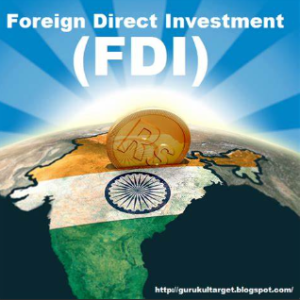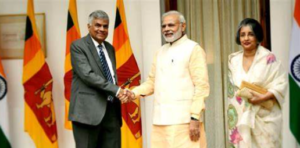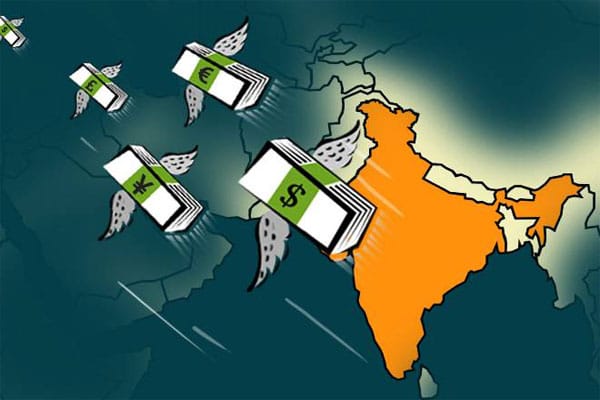Introduction

- The economic landscape of nations is significantly shaped by foreign direct investment (FDI), a vital driver for development, technological innovation, and global integration. The foreign direct investment (FDI) trajectories of India and Sri Lanka are noteworthy case studies within the South Asian environment, demonstrating the intricate interplay among economic policy, geopolitical factors, and market attractiveness in shaping capital inflows. India’s economy, among the fastest-growing and largest globally, has always aimed to attract foreign investment by liberalizing its regulations. The nation’s reputation as an appealing location for foreign direct investment (FDI) has been greatly enhanced by its large market size, variety of industries, and recent legislative changes focused on facilitating corporate operations. India’s goal has been to establish an environment favorable for foreign investors, encouraging job creation, technology transfer, and economic progress. This has been achieved through initiatives such as “Make in India” and reforms in industries including manufacturing, retail, and infrastructure. On the other hand, despite having a smaller economy overall, Sri Lanka benefits from several strategic locations, such as its proximity to important global trade routes and its highly educated workforce. The goal of the Sri Lankan government’s recent policy initiatives has been to promote economic growth and draw in foreign direct investment (FDI). Sri Lanka is now seen by international investors as an emerging market because of programs like tax breaks, special economic zones, and initiatives to make doing business easier. This extensive study aims to critically analyze the efficacy of Sri Lanka’s and India’s various economic policies in luring foreign capital while delving further into the subtle disparities in FDI trends. Through an analysis of the regulatory environments, geopolitical factors, industry prospects, and the consequences of recent policy changes, this evaluation seeks to reveal the complex factors driving FDI inflows and the ensuing effects on the economies of both countries. India and Sri Lanka are navigating their FDI plans against a unique environment of changing trade dynamics, geopolitical concerns, and the aftermath of the COVID-19 pandemic in the current global scenario. Comprehending the divergent strategies adopted by these two economies about foreign direct investment not only illuminates their ability to withstand and adjust to worldwide adversities but also provides significant understanding of their chances for long-term expansion, technological advancement, and heightened competitiveness in the global marketplace. In order to give a more thorough understanding of the advantages, disadvantages, and potential future paths of foreign direct investment (FDI) in the varied economic environments of India and Sri Lanka, this investigation aims to present a thorough analysis. Assessing these patterns and regulations can provide insightful knowledge and practical approaches for decision-makers, financiers, and interested parties seeking to negotiate the always changing landscape of international investment and economic growth.
- Furthermore, India has established itself as a leader in industries with room to develop in the future thanks to its responses to new global trends and technology, such as the encouragement of digital innovation and the adoption of renewable energy. The government’s emphasis on making doing business easier is demonstrated by programs like the introduction of the Goods and Services Tax (GST) and the Insolvency and Bankruptcy Code (IBC), which highlight the government’s dedication to fostering an atmosphere that is business-friendly and encourages foreign direct investment (FDI).
- Still, there are several facets to India’s FDI scene, including both achievements and difficulties. The full realization of India’s FDI potential across all sectors and regions remains hampered by enduring issues like bureaucratic complexities, regulatory uncertainties, and infrastructural gaps, despite the country having seen significant FDI inflows, particularly in technology-driven sectors and infrastructure development.
- India’s FDI story is shaped by the geopolitical environment and changing global economic dynamics, which affect investor decisions and views. The nation’s diplomatic contacts, trade agreements, and strategic posture as a major participant in regional and international markets all contribute to the complexity of its FDI trends and effects.
- This study aims to examine the delicate relationship between policy reforms, sector-specific possibilities, geopolitical variables, and the changing global economic landscape to provide a thorough analysis of India’s FDI patterns. This exploration aims to provide nuanced insights into India’s position as an investment destination and its potential for sustained economic growth and development amidst global uncertainties by closely examining the effectiveness of India’s economic policies in attracting FDI and evaluating their impact on capital inflows.
In order to draw in foreign direct investment (FDI) and boost capital inflows into their economies, Sri Lanka and India have both undertaken a variety of economic strategies. When evaluating their FDI trends, there are a few important factors to consider halfway through:
- India’s Investment Trends and Economic Policies:
- Liberalization Changes: Early in the 1990s, India started implementing major economic reforms, opening its economy to foreign direct investment. Policies were put into place that included loosening prohibitions on foreign ownership, cutting back on industrial licensing, and streamlining regulations.
- Sectoral Policies: With differing degrees of restrictions and conditions, India has opened several industries to foreign direct investment (FDI), including retail, insurance, defense, and telecommunications.
- Introduced in 2014, the “Made in India” initiative sought to increase manufacturing in India and attract foreign direct investment (FDI) by offering incentives, streamlining corporate procedures, and positioning the nation as a manufacturing hub.
- Tax Reforms: The introduction of the Goods and Services Tax (GST) and other tax reforms were intended to streamline the tax code and boost the investment environment.
- Infrastructure Development: In order to draw in more capital, improvements have been made to the roads, ports, and electricity systems.
- FDI Trends: Over the years, India has seen a steady increase in FDI inflows, especially in industries like services, telecommunications, and computer software and hardware.
Trends between FDI with Sri Lanka’s Economic Policies:
- Investment Promotion Policies: In order to draw foreign direct investment (FDI), Sri Lanka has implemented several policies. These include tax breaks, investment incentives, and preferential treatment for certain industries like infrastructure, tourism, and manufacturing.
- Commerce Agreements: To increase market access and ease commerce, Sri Lanka has signed both bilateral and regional trade agreements, which has an indirect impact on foreign direct investment (FDI).
- Infrastructure Development: To boost its investment climate, especially in ports and transportation, Sri Lanka, like India, has concentrated on infrastructure development.
- Political Stability and Policy Consistency: Attracting long-term foreign direct investment (FDI) requires sustaining political stability as well as consistent economic policies.
- FDI Trends: Several factors, such as political unpredictability, policy uncertainty, and regional economic conditions, have caused variations in FDI inflows to Sri Lanka. The nation has been working to improve the conditions that encourage sustainable FDI.
- Comparative Analysis and Impact: Ease of Doing Business: Sri Lanka has struggled with this area because of regulatory complications and bureaucratic roadblocks, while India has improved in this regard.
- Sectoral Focus: FDI is directed towards distinct sectors in both nations. While Sri Lanka has concentrated more on industries like tourism, manufacturing, and infrastructure, India offers a wide range of areas that are accessible for investment.
- Obstacles: Both countries must contend with issues including corrupt officials, bureaucratic red tape, inadequate infrastructure, and unclear policies that may discourage foreign direct investment (FDI).
- Prospects: Both countries’ future FDI trends will be greatly influenced by the efficacy of their economic policies, the stability of their governance, the development of their infrastructure, and geopolitical circumstances.
- To get comprehensive conclusions on FDI patterns in India and Sri Lanka, it is imperative to consider the changing economic scenarios, geopolitical dynamics, regulatory changes, and the global investment climate while evaluating these elements.

The FDI Policies and Trends in Sri Lanka:
- Investment Promotion: To entice foreign direct investment (FDI), Sri Lanka has put in place several policies. These include providing tax breaks, duty waivers, and other preferential treatment in industries like manufacturing, export-oriented businesses, infrastructure, and tourism.
- Free Trade Zones: In order to attract international investment, the nation created Free Trade Zones (FTZs), which offer infrastructure, tax breaks, and simplified restrictions for companies doing business there.
- Trade Agreements: To improve market access and foster an atmosphere that is more welcoming to international investors, Sri Lanka has signed trade agreements with several nations.
- Infrastructure Development: In order to increase connectivity and draw in investments, Sri Lanka has been concentrating on infrastructure projects involving ports, motorways, and electricity.
- Policy Stability: To keep investors’ confidence, policy stability and continuity are essential. FDI inflows are significantly influenced by Sri Lanka’s stable political environment and steady economic policies.
- Challenges: Sri Lanka must deal with issues like bureaucracy, political unpredictability, complicated regulations, and sporadic policy uncertainty, all of which can lower the country’s investment climate’s appeal.
- FDI Trends: Sri Lanka has experienced fluctuations in FDI inflows due to various challenges. While there have been periods of significant FDI growth, differences in investment patterns can be attributed to issues such as political unpredictability and policy concerns.
- Comparative Analysis with India: Sectoral Focus – India provides a broader spectrum of industries open for investment, while Sri Lanka adopts a more targeted approach, concentrating on sectors such as manufacturing, infrastructure, and tourism for FDI.
- Ease of Doing Business: Sri Lanka has faced challenges due to regulatory complications and bureaucratic obstacles, whereas India has demonstrated significant progress in improving its rankings for ease of doing business.
- To attract foreign direct investment, both India and Sri Lanka have strongly emphasized infrastructure development; however, the scope and pace of advancement may vary between the two nations.
- Political Stability: Although there have been political difficulties in both nations, maintaining stability and implementing consistent policies are essential to maintaining FDI inflows.
- Prospects: Future FDI patterns in Sri Lanka will be influenced by the efficacy of the nation’s economic policies, advancements in governance, the growth of its infrastructure, and geopolitical considerations.
- Understanding the targeted industries, policy stability, infrastructural development, and the effects of obstacles on the investment climate are all important components of evaluating Sri Lanka’s FDI trends. Together, these elements affect Sri Lanka’s appeal as a location for foreign direct investment (FDI) and its relative standing in relation to other economies, such as India.
Conclusion
- The foreign direct investment (FDI) landscapes of Sri Lanka and India exhibit subtle distinctions along with shared obstacles in their strategies for attracting foreign investment. While both countries have devised distinct economic policies to foster FDI, their paths and effects differ due to varying approaches, sectoral priorities, and economic conditions.
- India’s Foreign Direct Investment (FDI) Landscape: Propelled by extensive economic liberalization in the 1990s, India embarked on a reformative journey to attract FDI. The nation implemented policies aimed at fostering infrastructure development, streamlining business processes, and opening up various sectors. Exemplifying this effort is the ‘Make in India’ campaign, a strategic initiative to position India as a global manufacturing hub, leveraging FDI to drive industrial growth. Notably, the nation’s diverse industries, including telecommunications and services, have successfully attracted significant foreign investment.
- But problems still exist. The persistence of bureaucratic barriers, regulatory difficulties, and infrastructural deficiencies hinders sustained foreign direct investment development, even in the face of advances in the ease of doing business rankings. However, India’s enormous market potential, highly skilled labor pool, and ongoing legislative changes keep it appealing to international investors.
- Sri Lanka’s Foreign Direct Investment (FDI) Landscape: Despite its modest size, the country has actively sought to attract FDI by establishing Free Trade Zones (FTZs), offering tax benefits, and concentrating on key industries such as infrastructure, tourism, and manufacturing. The nation is committed to cultivating an investment-friendly environment, evident through its emphasis on trade agreements and efforts to enhance policy stability. Notably, the ongoing development of the nation’s infrastructure, particularly in ports and transportation, underscores Sri Lanka’s determination to elevate its economic standing.
- Despite these efforts, Sri Lanka encounters challenges in sustaining FDI. Fluctuations in Foreign Direct Investment inflows arise from factors such as political instability, bureaucratic obstacles, and sporadic policy uncertainties. These challenges underscore the critical importance of stable governance and consistent policies in maintaining investor trust.
- Comparative Study and Future Directions: India and Sri Lanka have different strategies from each other. India draws a wide range of FDI inflows due to its larger market size and wider range of sectors available for investment. Conversely, Sri Lanka strives for targeted foreign investments because of its strategic incentives and sector-specific focus.
- To enhance their appeal to foreign direct investment, both nations need to address issues such as bureaucratic red tape, complex regulations, infrastructure deficiencies, and policy uncertainties. Sri Lanka, in particular, must prioritize policy stability and address political instabilities to build sustainable investor confidence.
- Various factors will play a pivotal role in shaping the future FDI trends of both countries. The success of economic programs, improvements in governance, infrastructural development, and geopolitical considerations will significantly influence their investment landscapes. Collaborative efforts, regional alliances, and leveraging strengths in innovation and technology are key strategies that can enhance their potential for attracting FDI.
- In conclusion, both Sri Lanka and India show promise as investment destinations, but with different approaches and difficulties. Both countries must continue to reform, maintain policy stability, build infrastructure, and remove underlying barriers to use FDI as a catalyst for economic expansion, job creation, and sustainable development.
- Sri Lanka and India exemplify distinct strategies for attracting FDI, each presenting unique advantages and disadvantages. The trajectory of their FDI landscapes will be significantly influenced by sustained policy reforms, the elimination of administrative obstacles, improvements in infrastructure, the assurance of policy stability, and the cultivation of innovation ecosystems.
- In addition to promoting economic growth, cooperative initiatives, regional alliances, and a common dedication to establishing an investor-friendly climate would establish both countries as major players in the international investment arena and utilize FDI as a catalyst for sustainable development and prosperity.
- For both India and Sri Lanka to harness the full potential of foreign direct investment, it is imperative that they consistently foster partnerships and enact sustained reforms. The forthcoming expanded conclusion delves deeper into the specifics of cooperative methods and prospects for these nations.
Viraj Madusanka Dias Sooriyaarachchi
[Viraj Madusanka Dias Sooriyaarachchi is an accomplished writer who produces original, unique essays and articles on a variety of subjects. His goal is to offer thoughts, ideas, and facts in a distinctive and interesting way while also giving readers new insight and information on a range of subjects. His undergraduate degree, a B.com (hons) in marketing and management, was completed with a distinction of first-class and a 9.17 cumulative grade point average. He also finished a Coursera online course, a rural internship in India, and an assistant marketing manager internship at a tea firm in Sri Lanka.]
References
- Foreign Direct Investment (FDI) In India: Inflows In 2023 And Last 10 Years – Forbes India
- Foreign direct investment, net inflows (% of GDP) – Sri Lanka | Data (worldbank.org)
- Sri Lanka expects FDI to jump to $1.3 bln with India taking lead | Reuters
- Sri Lanka Foreign Direct Investment, 1977 – 2023 | CEIC Data
- Foreign Investment Can Help Sri Lanka Build Back (worldbank.org)
- ICME 2019 (329-344).pdf (ruh.ac.lk)
- Innovation, foreign direct investment (FDI), and the energy–pollution–growth nexus in OECD region: a simultaneous equation modeling approach | Environmental and Ecological Statistics (springer.com)
- FDI Policy in India | Invest India
- Foreign Direct Investment Statistics: Data, Analysis and Forecasts – OECD
- lib.ruh.ac.lk/bitstream/handle/iruor/8406/03 – Sumanaratne. B.M.pdf?sequence=1
- FDI in India: Foreign Direct Investment Opportunities, Policy | IBEF
- Openness to foreign investment and recent liberalisation reforms | Middle East and North Africa Investment Policy Perspectives | OECD iLibrary (oecd-ilibrary.org)




